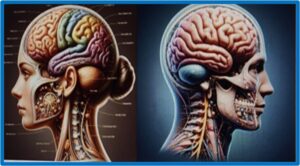The 10% Brain Myth: Unveiling the Truth Behind
Our Powerful Minds
The idea that we only use 10% of our brain is
a popular myth. We use all brain parts, just not all simultaneously.
The Brainstem: Our Ancient Core
The brainstem is the oldest part of our brain,
responsible for vital functions like breathing and heart rate. It’s our
survival center, working tirelessly in the background.
The Subconscious: A Mysterious Realm
The subconscious is thought to reside throughout the
brain, not in a specific location. It often influences our thoughts, emotions,
and behaviors without realizing it.
Why Have 90%? A Question of Evolution
The brain’s complexity is a product of
millions of years of evolution. Each part serves a purpose,
even if we don’t fully understand it yet. This “extra” capacity
allows for adaptability and learning.
Unlocking Our Full Potential
While we may not have untapped superpowers, understanding
how our brains work can help us lead healthier, more fulfilling lives. By
challenging ourselves and learning new things, we can continue to grow and
evolve.
Geniuses throughout history, like Albert
Einstein, Leonardo da Vinci, and Marie Curie, possessed exceptional
intellectual abilities in specific domains. Their brains might have had unique
structures or functions, but their dedication and passion played a crucial
role.
We aren’t all at the same intellectual level
due to a combination of factors:
Genetics: Inherited traits
influence our cognitive potential.
Environment: Upbringing,
education, and experiences shape our minds.
Motivation: Personal drive and
interests determine how we utilize our abilities.
Intelligence is a multifaceted concept with
various forms; everyone has unique strengths and weaknesses.
Comparing ourselves to geniuses is less important than focusing on our growth
and development.
After a traumatic brain injury, the brain can
reconnect and heal through neuroplasticity. This is the brain’s ability to
reorganize itself by forming new neural connections.
Here’s how it works:
Spontaneous Recovery: In
the initial stages after an injury, the brain may experience some spontaneous
recovery as swelling reduces and inflammation subsides.
Axonal Sprouting:
Damaged axons (the parts of neurons that transmit signals) can sometimes sprout
new connections to replace lost ones.
Dendritic Branching:
Dendrites (the parts of neurons that receive signals) can also branch out to
form new connections.
Synaptic Plasticity: The
strength of existing synapses (connections between neurons) can be modified to
compensate for lost connections.
Neurogenesis: In
some cases, new neurons may be generated in specific brain areas.
The extent of recovery depends on various factors,
including the severity and location of the injury, the individual’s age and
overall health, and the availability of rehabilitation therapies.
Rehabilitation Therapies:
Physical Therapy:
Helps to improve motor function and coordination.
Occupational Therapy:
Assists in regaining skills needed for daily living.
Speech Therapy: Aids
in improving communication skills.
Cognitive Therapy:
Focuses on improving memory, attention, and problem-solving skills.
Recovery from a traumatic brain injury is
often a long and challenging process, but with appropriate therapies and
support, the brain has a remarkable ability to heal and adapt.
Brain research is a vast and ever-evolving
field. Here are some resources to explore further:
Government Initiatives:
The BRAIN Initiative: A
collaborative research effort to revolutionize our understanding of the human
brain.
https://braininitiative.nih.gov/
Academic Resources:
Direct Links to Very Important Journals in
Neuroscience: A comprehensive list of leading neuroscience
journals.
https://uark.libguides.com/c.php?g=79250&p=506866
Study links school environment to brain
development: Stanford research highlights the school
environment’s impact on brain development.
Organizations:
Society for Neuroscience: A
global organization dedicated to advancing understanding of the brain and
nervous system. https://www.sfn.org/
These are just a few starting points for exploring brain
research. The field is constantly evolving, so stay curious and keep exploring!
The brain is a complex organ with numerous
parts, each with specific functions. Here are the leading labels of the brain:
Cerebrum: The most significant
part of the brain, responsible for higher-order functions like thought,
perception, and action. It’s divided into two hemispheres, connected by the
corpus callosum.
https://my.clevelandclinic.org/health/body/23083-cerebrum
Cerebellum: Located at the back
of the brain, it coordinates movement, posture, and balance.
https://my.clevelandclinic.org/health/body/23418-cerebellum
Brainstem: This connects the brain to the spinal
cord and controls essential functions like breathing, heart rate, and
consciousness. It consists of the midbrain, pons, and medulla oblongata.
https://en.wikipedia.org/wiki/Brainstem
Thalamus: Acts as a relay
station for sensory information, directing it to the appropriate areas of the
cerebrum for processing.
https://my.clevelandclinic.org/health/body/22652-thalamus
The hypothalamus regulates various bodily
functions, including temperature, hunger, thirst, and sleep. It also controls
hormone production in the endocrine system.
https://my.clevelandclinic.org/health/body/22652-thalamus
Pituitary Gland: This small gland is located below
the hypothalamus. It produces and releases hormones that regulate a wide range
of bodily functions.
https://my.clevelandclinic.org/health/body/21459-pituitary-gland
Pineal Gland:
Produces melatonin, a hormone that regulates sleep-wake cycles.
https://my.clevelandclinic.org/health/body/23334-pineal-gland
Limbic System: A group of structures involved in
emotions, memory, and motivation. It includes the amygdala, hippocampus, and
cingulate gyrus.
https://www.britannica.com/science/limbic-system
This is just a brief overview of the leading
labels of the brain. These structures are further divided into smaller regions
with even more specific functions. Understanding the brain’s complexity is
crucial for understanding how we think, feel, and behave.





